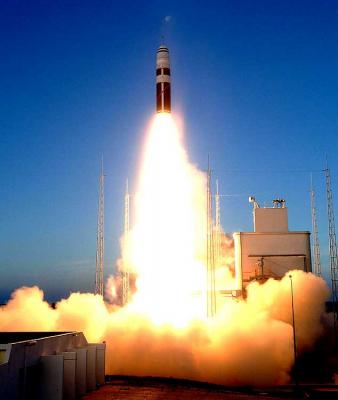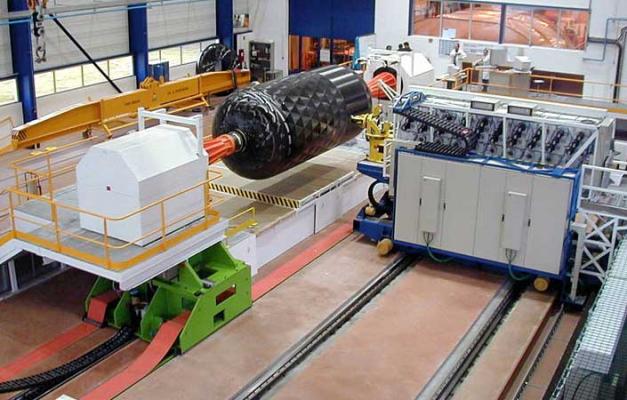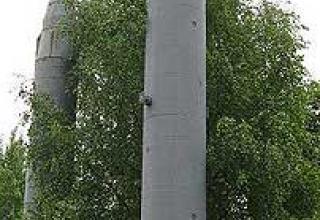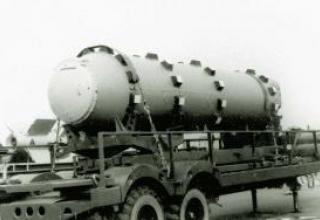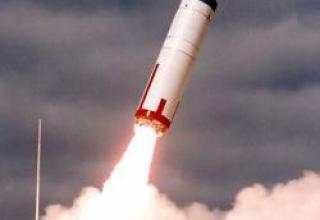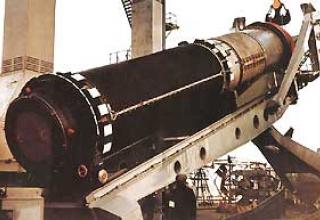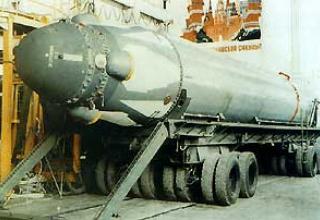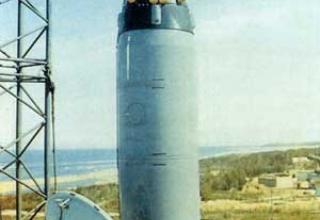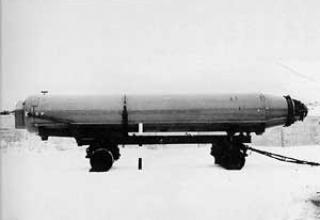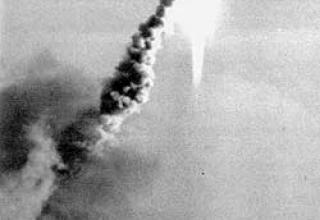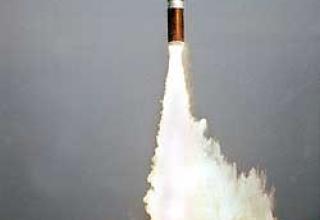The history of the creation of the most modern French M51 SLBM dates back to the first half of the 90s, when in 1992 the Minister of Defense of the French Republic authorized the beginning of research work on a promising intercontinental missile designed for French second-generation SSBNs of the "Le Triomphant" class. By 1993, requirements had been developed for a new missile designated M5 - it should have a range of up to 11,000 km, be equipped with RSHI with a number of combat units up to 10 and have on board a complex of missile defense coping capabilities (SLC ABM). It was also supposed to adapt this missile to the land-based version of the silo-based ICBM, but in 1993 this version was excluded. In 1993, work began on shaping the look of the M5 SLBM. Due to numerous technical difficulties, the M51 program was adopted in February 1996, according to which the range was reduced to 10,000 km, the number of combat units of MHF IF was reduced to 6, and accuracy requirements were loosened. Besides, the date of adoption of the newest combat units (BC) with combat units (BC) TNO was shifted to 2015, because in order to speed up the work it was decided to use in the first stage the already existing BCs with BC TN-75, as well as the corresponding CCB anti-missile defense, due to which the range and accuracy was further reduced. The initial date of adoption of the new complex was named 2008, but due to technical difficulties the date was gradually shifted and was called July 2010 (in fact, the complex was adopted in October 2010).
The head of the M51 program is the European international consortium "EADS Space Transportation". Scientific support is provided by the French state organization sEREB (Organisation for Ballistic Missile Research and Development). G2P group, uniting SNPE and "Snecma Propulsion Solide" companies, was chosen as the main contractor for the creation of the engine. The most important role in the creation of the new SLBM is played by SAGEM (developing control and guidance system), SODERN, THALES, CNIM, DCN. BC traditionally develops "Direction des Affaires Militaires of the Commissariat a l'Energie Atomique" (French nuclear authority). The French defence supply agency Delegation Generale pour l'Armement has a Coelacanthe project to coordinate and accompany the M51 programme. Full-scale missile development began in 1998, and in 2004 the EADS consortium began producing prototype missiles. According to the officials of this project, the methods of mathematical and computer modeling were used in the course of the work much wider than before, which ensured the choice of a number of optimal solutions and significant cost savings. It is assumed, for example, that the use of modern design technologies will reduce the volume of joint flight tests by at least three times.
A major problem was the deployment of M51 missiles in silos of existing Le Triomphant class SSBNs, which were originally built for M45 SLBMs. In order to ensure minimum reconfiguration of the launch silos, the new SLBMs are to be placed in a special lightweight thin-walled all-walled launch container made of organic materials. Modelling technologies are also widely used in the development of the TNO, a prospective combat unit (BC) that promises to be the first French BC to be built without full-scale nuclear testing. For the purposes of creating this and other advanced warheads after the cessation of nuclear testing in 1996, France has been operating the Simulation programme, under which it has created: the Megajoule Laser system (which began work in 2009), the Airix X-ray system (which began work in 2000) and the TERA-10 new generation supercomputer (which began work in 2005).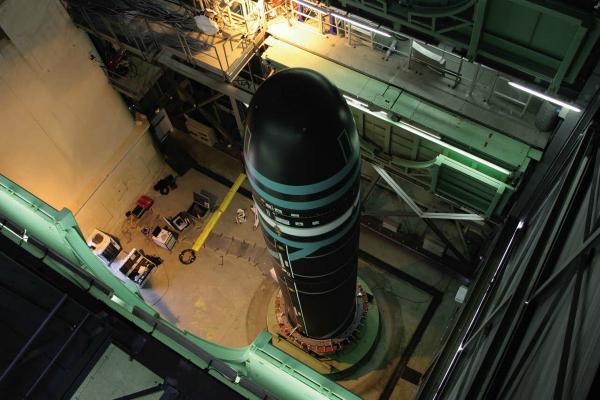
In the course of work on the M51 program, the infrastructure for the development of the missile and its parts was created virtually overwhelmingly large. In Toulon, on the Mediterranean coast of France, a special submersible stand for underwater launch of large SLBM models was built, and at the Biscaross range, a special well 100 meters deep, into which the stand is submerged, which is a missile silo with a rocket inside and a set of appropriate equipment.
All this equipment (see Photo1, Photo2, Photo3, Photo4 ) is used for testing missile launches from underwater position. In addition, a ground launch pad for SLBM launches and marching engine test stands have been built.
According to French sources, the first stage of the missile successfully passed firing tests in early 2005, and by the end of 2006 the firing tests had already passed all marching and launch stages. A mass-produced mock-up of the missile was thrown from an underwater position. In November 2006, M51 made its first test launch from the ground launch pad. In June 2007, the missile made a second test launch, also from the ground launch pad. The first launch of the modified missile from an underwater position using specially designed infrastructure took place in November 2008, and the first launch from a SSBN was planned for 2009, but was postponed to 2010. French scientists and engineers have made all the necessary changes to the design of the SLBMs and part of the Le Terrible SSBN test programme has been successfully completed. As a result of these efforts, Le Terrible SSBNs were launched from an underwater position in January 2010. All the SSBN and SLBM systems were operational as usual, and the training SSBNs arrived in the target area of the Atlantic at a specified time.
In July 2010, Le Terrible again successfully launched the M51 SSBN from an underwater position, which was the fifth in a series of test launches (all successfully) of this SSBN. The complex was officially put into service in October 2010 (at the same time as the Le Terrible SSBN from the industry). Officials noted, however, that "crew alignment" would still take place over the next few months, and the SSBNs would be subjected to additional tests (probably additional launches/launches of M51 SLBMs during this period) before going on their first combat patrol at sea (not before 2011). Upgrades to the new missile system and three previous SSBNs of the same class will start soon (probably, also from 2011). The rearmament process should be completed by the end of 2015.
A total of no more than 10 test launches were originally planned. The first missiles (version M51.1) are scheduled to be on alert on board the fourth and final Le Triomphant class SSBNs, Le Terrible, in the first half of 2011. The remaining 3 SSBNs ("Le Triomphant", "Le Temeraire", "Le Vigilant") are to be re-equipped with new SLBMs by 2015.
Thanks to advances in materials science and the development of new fuels, the developers are declaring a 35-year life span for the new missile. Equipping the missile with the new BC TNO and SSB missile defense is planned for the period not earlier than 2015. Probably, the missile's electronics will be upgraded as well (accuracy, resistance to fossil fuels, etc. will be improved). According to the plans of the French Defense Ministry, all missiles will be brought to version M51.2 no later than 2020.
Composition:
The ballistic missile of the M51 submarines (see diagram) is a three-stage missile with sequential arrangement of stages. All three marching stages are manufactured by winding from light heat-resistant organic materials with a high degree of strength. New types of mixed high-energy solid fuels are used on all stages of the missile. According to a number of sources, the development of solid propellants for the new SLBM has benefited greatly from the experience gained in the development of launch accelerator boosters for the most advanced European Arian-5 booster. The solid propellant engines of all three marching stages have one steerable swivel nozzle, which is recessed into the hull when not in use to shorten the missile length. The nozzle of each stage controls the rocket at the stage operation site through the channels of pitch and yaw.
Management on a roll at work of marching steps is not made, and the stored error is eliminated on a site of work of a solid-fuel stage of cultivation. Electric drives (developed and manufactured by Thales Airborne Systems together with Goodrich Actuation Systems) are used for the first time on the new SLBM in the nozzle control system instead of hydraulic drives, which, according to French sources, allowed reducing the length and weight of the SLBM and simplifying its maintenance. The marching stage nozzles and inlays are made of their high strength, heat-resistant organic materials.
The breeding stage of M51 SLBMs is traditionally solid fuel for French rocket builders, which avoids the presence on board of flammable, self-inflammable poisonous liquids used on liquid (traditional for Soviet/Russian SLBMs) or combined (British Polaris A3TK) breeding stages.
The M51 missile will carry a dividable warhead (DHHN) with 6 combat units (BB) and a BMD SLC. M51.1 variant SLBM combat units are equipped with TN-75 combat units (BC) and are modern, small-size, high-speed and low-profile ABs resistant to foammable substances. The TN-75 BC also has a high level of resistance to foammable substances, a large number of blasting options and variable power with a maximum value of about 150 kt. The M51.2 version will carry the BC with TNO BC and the corresponding CSP PRO. Designed BC TNO - promising small, high-speed and low-profile units, resistant not only to PSNF, but also to the damaging factors of weapons based on new physical principles. TNO BC will have a large number of blasting options and variable power with a maximum value of about 300 kt. The booster of the M51.2 missile will be more accurate and lightweight, which will allow to increase the range, accuracy and area of the missile's deployment area without changing the launch stage. According to some data, the number of ABs on this modification is planned to be reduced from 6 to 4.
The M51 is the first French SLBM to use an astronautical navigation system in addition to the traditional inertial one. This, together with a significant upgrade of the INS instruments, has made it possible to significantly increase the accuracy of the firing. In the future, satellite navigation systems will also be used to improve accuracy.
The M51 SLBM, modelled on the American Trident SLBM, uses a retractable aero-needle, which significantly reduces the aerodynamic resistance of the missile in the dense atmosphere.
In general, evaluating the SLBM project, it can be noted that the French missile builders have remained faithful to their traditional approach of gradually increasing the missile's TTH. The M51.1 rocket represents significant progress in all respects compared to its predecessor, the M45 rocket. M51.1 is the first French intercontinental class ballistic missile and its entry into service (together with the final re-equipment of French SLBMs on the latest SSBN "Le Triomphant") will repeatedly increase the striking potential of French SLBMs, even without increasing the number of carriers and warheads. Bringing the M51 missile to the M51.2 level in the future will finally bring French naval SNF to the most advanced world level in this class of weapons and will allow them to engage absolutely the entire range of existing strategic targets.
Characteristics:
| Range of fire, km | 9000 (according to other data 6000-8000 and 10000 in M51.2 variant) |
| KVO, km | 0.25 (0.2 in M51.2 version) |
| Header type | RSCH IN with CSP PRO |
| Number of BB | 6 |
| Every BB's BC power, kt. | 100 (300 in M51.2 version) |
| The mass of the rocket, t | 56 |
| The length of the rocket, m | 12 |
| The diameter of the rocket, m | 2,3 |
| The operating time of each march step, s | 60 |
| Number of steps | 3 marches + breeding stage |
| Number of SLBMs per SSBN | 16 |
Testing:
Terms of development of the M-1 complex were ahead of the terms of delivery of the head ship at Prospect 61 of Plant № 1701 (SKR-25 from 9.10.62 "Komsomolets of Ukraine") - so the Order of the USSR CM № 2110 of 30.07.1959. joint tests of M-1 were transferred to the rocket ship "Bravy" pr.56K. Tests on "Bravo" were held in two stages - from 5.01.62 to 12.03.62 and from 12.03.62 to 30.04.62. During the tests it was noted that the time of "Yatagan" exit from the cold position was 5 minutes, the range of "Yatagan" escorting the target was 42 km with a 50% probability of capture and 36 km with a probability of 80%. The missile's range was 15 km, and the self-destruct time was 26 seconds.
During the tests of the complex was shot down six target aircraft MiG-15M, flying at an altitude of 0.6 to 10 km, with missiles missed from 9 to 48 meters. According to the commission, the probability of hitting the aircraft at a miss of 20 meters is 0.9, while at a miss of 40 meters - 0.4-0.6. The M-1 complex could hit targets flying at a speed of up to 600 meters per second. The target can maneuver at altitudes up to 4 km with an overload of 3 - 4 g, and at high altitudes - up to 2 - 3 g. The speed of the ship during launches can be up to 36 knots. There was no firing from Bravoi on surface targets.
According to the results of tests on "Bravoi" the M-1 SAM system was recommended for adoption for service.
Sources:
- www.defence.gouv.fr
- www.netmarine.net
- M51 Gives France More Flexible Deterrent To Meet Changing Threats /www.aviationweek.com/
- www.defence-aerospace.com
- www.nuclearweaponarchive.com
- www.globalsecurity.org
- www.space.eads.net
- www.naval-technology.com
- Национальная оборона, 2006, №4
